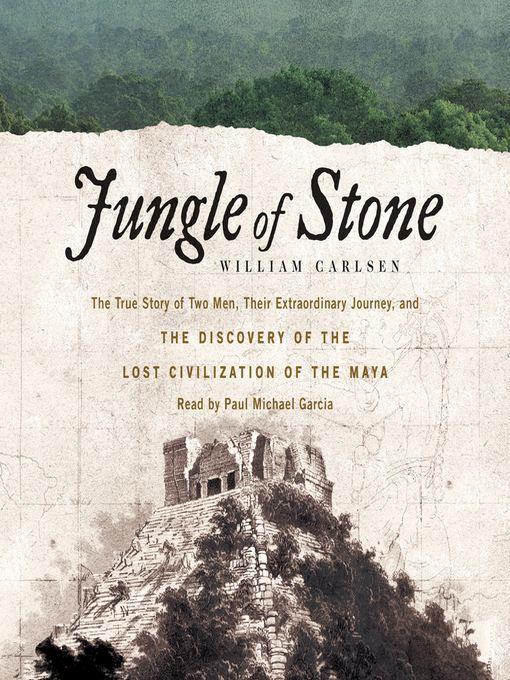
Jungle of Stone
The Extraordinary Journey of John L. Stephens and Frederick Catherwood, and the Discovery of the Lost Civilization of the Maya
فرمت کتاب
audiobook
تاریخ انتشار
2016
نویسنده
Paul Michael Garciaناشر
HarperAudioشابک
9780062445308
کتاب های مرتبط
- اطلاعات
- نقد و بررسی
- دیدگاه کاربران
نقد و بررسی

February 15, 2016
Journalist Carlsen travels through Mexico, Guatemala, and Honduras, tracing the footsteps of Frederick Catherwood and John Lloyd Stephens, the amateur archaeologists whose 1839 expedition offered Euro-Americans their earliest awareness of Mayan civilization. At the time, the cultural and religious chauvinism of whites on both sides of the Atlantic encouraged the view that indigenous Americans had been nothing more than “primitive, inferior people.” But Stephens and Catherwood’s journey, as described through their pivotal writings, provided irrefutable evidence the Maya had created “one of the most sophisticated early civilizations on earth” and forced their readers to rethink basic assumptions about race, culture, and evolution. Carlsen depicts the two men’s arduous expedition with verve and vigor, though some readers may find that the book’s staccato narrative structure doesn’t do the material justice. The book would also have been strengthened by at least a brief engagement with the longer history of European encounters with Central America; Hernán Cortés and his conquistadors had been dazzled by Aztec culture early in the 16th century, so at least some Europeans were aware that indigenous Central Americans were not savages. Nonetheless, Carlsen finely explicates the challenges of the Catherwood-Stephens expedition and the wonders they found. Agent: Geri Thoma, Writers House.

October 1, 2015
In 1839, John Lloyd Stephens, U.S. special ambassador to Central America, and Frederick Catherwood, a British architect and draftsman, marched into the Yucatan's uncharted jungles to do a little exploring and discovered astonishing ruins of the Mayan civilization--1,500-year-old temples and pyramids rivaling Egypt's, plus evidence of advanced art, writing, and science. Pulitzer Prize finalist Carlsen reconstructs the journey. Lots of in-house love for this one; with a 75,000-copy first printing.
Copyright 2015 Library Journal, LLC Used with permission.

March 15, 2016
Journalist Carlsen examines the adventurous lives of American diplomat, lawyer, and explorer John Lloyd Stephens (1805-52), and British artist and architect Frederick Catherwood (1799-1854), whose many grueling archaeological expeditions through the dangerous jungles of Central America were among the first to document the majestic ruins of the Maya civilization. Stephens and Catherwood's investigation of then-unknown Mayan sites such as Copan and Palenque proved the existence of a highly sophisticated ancient indigenous civilization that challenged 19th-century views on Western cultural superiority. Combining Stephens's travel writing and Catherwood's masterly illustrations, books such as Incidents of Travel in Central America, Chiapas, and Yucatan, as well as a later volume, became best sellers that introduced a mysterious, hidden world to an avid audience. VERDICT Carlsen's cogent and well-written dual biography successfully illuminates the fascinating tale of these intrepid pioneers of a lost civilization. For recreational readers or researchers interested in the rediscovery of Mayan culture, the history and archaeology of Central America, or archaeological adventure tales that make Indiana Jones seem tame. Readers may also enjoy the original works of Stephens and Catherwood. [See Prepub Alert, 8/31/15.]--Ingrid Levin, Salve Regina Univ. Lib., Newport, RI
Copyright 2016 Library Journal, LLC Used with permission.

October 1, 2015
In 1839, John Lloyd Stephens, U.S. special ambassador to Central America, and Frederick Catherwood, a British architect and draftsman, marched into the Yucatan's uncharted jungles to do a little exploring and discovered astonishing ruins of the Mayan civilization--1,500-year-old temples and pyramids rivaling Egypt's, plus evidence of advanced art, writing, and science. Pulitzer Prize finalist Carlsen reconstructs the journey. Lots of in-house love for this one; with a 75,000-copy first printing.
Copyright 2015 Library Journal, LLC Used with permission.

Starred review from February 1, 2016
Daring adventurers unearth a buried civilization. In his thrilling debut history, journalist and Pulitzer Prize finalist Carlsen traces the arduous journeys of lawyer John Lloyd Stephens and architect/artist Frederick Catherwood into the jungles of Central America. Both seasoned travelers to Rome, Greece, and throughout the Middle East, in 1839, when the two boarded a ship bound for the Gulf of Honduras, they had read only "vague reports of intricately sculpted stones" hinting at the existence of "a hidden unknown world." Those reports, and the intrepid voyages of naturalists such as Alexander von Humboldt, fueled their "hunger for adventure, the quest, the whiff of danger." Danger proved more than a whiff on 2,500 miles of life-threatening travel--both men contracted malaria and other tropical diseases, and civil wars raged--as they pursued their dream. In a battered Toyota, Carlsen followed their footsteps, and he evokes in palpable detail the tangled forests, punishing deserts, and cliffhanging mountain paths that they traversed. Stephens and Catherwood had no idea what to expect: common knowledge had it that Central America had been inhabited by primitive indigenous tribes. But they found shocking evidence of a sophisticated culture. "Architecture, sculpture, and painting, all the arts which embellish life, had flourished in this overgrown forest; orators, warriors, and statesmen, beauty, ambition, and glory had lived and passed away," Stephens wrote in a travel book, impressively illustrated by Catherwood, that became a bestseller. "It was a mystery," Carlsen writes, "of staggering implications." As the "acknowledged progenitor of American archaeology," Stephens could only guess at what he had found: he lacked the methodology and tools that would enable later archaeologists to date findings and flesh out Mayan history. A subsequent trip in 1841 yielded another volume, so eagerly anticipated that it was a bestseller even before "rapturous reviews" appeared. A captivating history of two men who dramatically changed their contemporaries' view of the past.
COPYRIGHT(2016) Kirkus Reviews, ALL RIGHTS RESERVED.

























دیدگاه کاربران